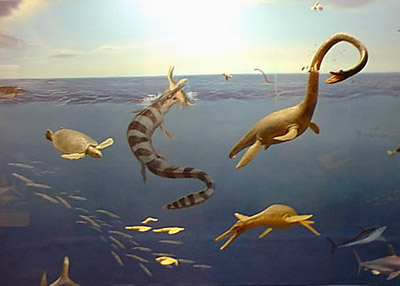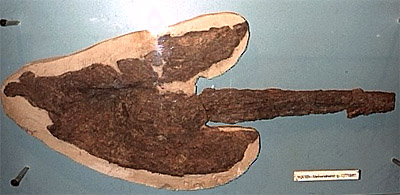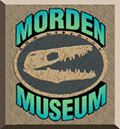 |
|||
|
|||
|
Copyright Manitoba once home to Tusoteuthis, an extinct species of giant squid BY MIKE WADDELL* * Curator, Morden District Museum, Morden, Manitoba, Canada.
The Giant SquidFrom Jules Verne's timeless classic "20,000 Leagues Under the Sea" to the Norse legend of the Kraken, sea monsters have long filled man's imagination with awe and mystery. A good number of these myths are likely based on an actual creature, the elusive giant squid.The squid belongs to a group of animals called cephalopods, which includes the octopus, the pearly nautilus, cuttlefish and the extinct ammonites. Squids are among the most complex and highly organized species of invertebrates (animals without backbones). They range in size from tiny animals (4 cm long) to the gigantic Archituethis, the giant squid that can reach 18 m in length. The largest specimen ever recorded was washed upon the shore in New Zealand in the late 1800's. It measured 60 feet long from the tip of its torpedo-shaped body to the end of its two feeding tentacles. The creature weighed about a ton. Scientists believe they may grow as long as 75 feet.
Enigmatic CreatureNo living giant squid has ever been maintained in an aquarium or marine institution. This adds to the intrigue of these creatures of the deep sea. "We probably know more about dinosaurs than about the giant squid," says Dr. Clyde Roper of the Smithsonian's Museum of Natural History. What is known is fascinating.Giant squid have the most highly developed brain of any invertebrate. They have the largest eye in the animal kingdom, as large as a hubcap. Unlike the octopus, giant squids have 10 tentacles. The eight shorter arms are as thick as a man's thigh and have rows of circular toothed suckers. Two longer, thinner tentacles end in club-like extensions used for acquiring prey. At the center of this teeming mass is a strong parrot-like beak coupled with a toothed tongue. It is easy to see how the giant squid has worked its way into the stuff of legend
Out of Myth and into MordenWhat does this spectacular creature have to do with us in Morden, over a thousand miles from the nearest ocean? One must first consider the fact that 80 million years ago Manitoba was drastically different than it is today. A shallow sea covered the entire interior of North America, stretching from the Gulf of Mexico to the Arctic Circle. At that time Morden was home to a wide variety of strange sea faring creatures. The best known of these are the mosasaurs and plesiosaurs that are on display at the Morden Museum. However there was another creature that swam these ancient waters.
Fossil SquidFossilized remains of extinct species of giant squid have been excavated in the bentonite quarries near Morden. Since squid have no bones to fossilize, all that remains is the pen; stiff rods of connective tissue that formed inside the animal to give it support. The fossil squids found in southern Manitoba are among the largest known, indicating sizes ranging up to 60 feet in length. Similar fossils have been found in Kansas and in Europe. Dr. Betsy Nicholls and Henry Isaak published the first scientific paper on Manitoba's fossil squids while working at the Morden Museum in 1987. Their study helped add to the body of knowledge of these "real life" sea monsters. It is interesting to imagine Tusoteuthis, the 80 million-year-old giant squid, propelling its way through the waters over what would become the corn and wheat fields of Morden.Giant squid remains are on display at the Morden Museum, along with a host of other fascinating creatures that lived in our area during the time of the Dinosaurs. Come and learn about the creatures that make an important part of our natural history.
Museum Information:
Copyright © 2001 Mike Waddell This article may not be copied, distributed or reprinted in any form without the author's permission. To contact the author, please use the e-mail address provided. If you are unable to contact the author, please contact the Canadian Rockhound. Authorized reprints must acknowledge the author, original source and the Canadian Rockhound, and include the website URL address of the Canadian Rockhound. The preceding article was first published in the February 2000 issue (column no. 3) of the Morden Times under the original title "A Real Sea Monster in Morden." Article submitted by Mike Waddell. Reprinted in the Canadian Rockhound with permission. The photographs and drawings for this article were provided courtesy of Mike Waddell, Laura Lea and Ian Pentland. Photographs used in this article may not be copied, distributed or reprinted in any form without permission. Please contact the author for more information.
|
||||
 
Copyright © 2001 Canadian Rockhound
Back Issues |
News & Events |
Junior Rockhound
|
||||



